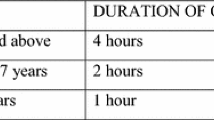Abstract
This paper reports on the frequency and distribution of seclusion or restraint (SR) episodes among 1,266 adult inpatients at a state psychiatric hospital during the 2004 calendar year. Data on the concentration of SR episodes over patients and time can assist in planning alternative, recovery-oriented treatment models. Fifteen percent (N = 194) of patients experienced seclusion or restraint. Sixty-three percent of all seclusion hours were concentrated among only ten patients. Likewise, the ten patients with the most restraint hours constituted nearly 65% of total restraint hours for the year and 48% of all restraint episodes. Variables accessible through administrative data accounted for modest seclusion and restraint variance. A comprehensive strategy to prevent SR episodes requires tailored interventions targeted to known high-risk individuals and development of general hospital-wide alternatives to SR. General alternatives require greater attention to staff education, administrative oversight, de-escalation and debriefing practices, patient involvement, and other recovery-oriented practices to reduce or eliminate use of seclusion and restraint.


Similar content being viewed by others
References
Weiss E. Deadly restraint: a nationwide pattern of death. Hartford Courant, October 11, 1998.
Busch AB, Shore MF. Seclusion and restraint: a review of recent literature. Harvard Review of Psychiatry. 2000;8:261–270.
Fisher WA. Restraint and seclusion: a review of the literature. American Journal of Psychiatry. 1994;151:1584–1591.
National Technical Assistance Center (NTAC). Violence and coercion in mental health settings: Eliminating the use of seclusion and restraint. Networks. Summer/Fall 2002:1–19.
Frueh BC, Knapp RG, Cusack KJ, et al. Patients’ reports of traumatic or harmful experiences within the psychiatric setting. Psychiatric Services. 2005;56:1123–1133.
Robins CS, Sauvageot JA, Cusack KJ, et al. Consumers’ perceptions of negative experiences and “sanctuary harm” in psychiatric settings. Psychiatric Services. 2005;56:1134–1138.
Crenshaw WB, Cain KA, Francis PS. An updated national survey on seclusion and restraint. Psychiatric Services. 1997;48:395–397.
Way B. The use of restraint and seclusion in New York State psychiatric centers. International Journal of Law and Psychiatry. 1986;8:383–393.
Donat DC. An analysis of successful efforts to reduce the use of seclusion and restraint at a public psychiatric hospital. Psychiatric Services. 2003;54:1119–1123.
LeBel J, Stromberg N, Duckworth K, et al. Child and adolescent inpatient restraint reduction: a state initiative to promote strength-based care. Journal of the American Academy of Child and Adolescent Psychiatry. 2004;43:37–45.
Smith GM, Davis RH, Bixler EO, et al. Pennsylvania State Hospital system’s seclusion and restraint reduction program. Psychiatric Services. 2005;56:1115–1122.
Myers M. Principles of positive behavioral support. Paper presented at the Washington State Behavioral Health Conference, June, 2005.
Donat DC. Encouraging alternatives to seclusion, restraint, and reliance on PRN drugs in a public psychiatric hospital. Psychiatric Services. 2005;56:1105–1108.
Author information
Authors and Affiliations
Corresponding author
Rights and permissions
About this article
Cite this article
Hendryx, M., Trusevich, Y., Coyle, F. et al. The Distribution and Frequency of Seclusion and/or Restraint among Psychiatric Inpatients. J Behav Health Serv Res 37, 272–281 (2010). https://doi.org/10.1007/s11414-009-9191-1
Received:
Accepted:
Published:
Issue Date:
DOI: https://doi.org/10.1007/s11414-009-9191-1




